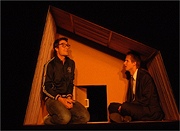Lynne Williams' talk The National Institute of Dramatic Art (NIDA) - Vital to Australia's Cultural and Innovation Infrastructure'
Lynne Williams, Director, The National Institute of Dramatic Art
20 April, 2012 at the Australian Embassy Tokyo
Thank you for your invitation to speak. I am delighted to be here.
My topic for this evening is:
THE NATIONAL INSTITUE OF DRAMATIC ART (NIDA) - VITAL TO AUSTRALIA'S CULTURAL AND INNOVATION INFRASTRUCTURE.
Australia's former Minister for the Arts, the Honourable Peter Garrett is quoted as saying:
"The arts make an enormous contribution to our identity, community and economy...As innovation becomes increasingly central to growing new and sustainable economies, there is amplified recognition of the role that creativity and the arts play as a driver of innovation."
This evening I want to tell you how I believe NIDA is increasingly becoming vital to Australia's cultural and innovation strategy, supporting and nurturing the creative Australia that is the key to the government's innovation strategy.
NIDA's vision for the future is two fold –
- to be a leader of innovation within a global community
- and to bring an understanding and appreciation of the arts to all Australians, enriching their everyday lives and encouraging them to explore their own creative potential.
But first, a little background on the institute. NIDA is Australia's leading national training institution for the dramatic arts, which builds and maintains a store of creative professionals and dynamic arts practice.
The impact of NIDA goes beyond the success of its international stars, although these people have been enormously valuable for Australia in culture, diplomacy, business and economically. Everyone in the world is familiar with the names of our graduates Cate Blanchett and Mel Gibson, but for over 50 years, NIDA has been seeding Australia's domestic arts scene with gifted and highly trained actors, directors, designers, stage managers, theatre craftspeople and technicians.
The success of NIDA's graduates has been intrinsically linked to the high standard of training for the theatre offered in the last 52 years. This training is based on a collaborative conservatoire model, an immersive, practice based learning program where all courses come together to produce 10 major works each year with extremely high production values. As in industry, the process begins with a concept explored and researched by director and designer and comes to fruition in a production involving around 60 students.
I wanted to give you a glimpse into this process by showing you some images of a recent production of A Midsummer Nights Dream. You will see some early ideas researched by the student set and costume designer; the set, props and costumes coming together for the final rehearsal with the production crew and actors.




We are very proud of the high quality of our theatre training and the results that the students are able to achieve. However, NIDA cannot rest on its laurels. We have a responsibility to not only nurture today's theatre practitioners but to seek to meet the challenges of the constantly evolving technological and demographic environment in which the theatre, as we know it, will live or die!
NIDA's Vision for the Future therefore, is a continually evolving education and training program to satisfy and indeed challenge, a changing arts environment and the changing expectations of audiences.
While theatre skills will always be at the heart of our training, NIDA now needs to offer students access to training in a broader range of performance contexts.
NIDA needs to familiarise students with the latest technology and train them for employment in new and constantly evolving areas of the industry. Graduates need to be equipped for an environment in which art and technology are converging. Live performance is increasingly being augmented with technology and artists are providing the content for technology, such as in computer games and digital media forms.
Film, television and animation are increasingly offering significant employment opportunities to graduates of all courses. NIDA works closely with the Australian, Film, Television and Radio School on joint projects but we have now created an industry standard film and television studio on campus and created our own screen department, thanks to the generosity of Channel 7. The new immersive film and television program is providing students with advanced skills in screen and we are beginning to explore other multi media and digital enhancements to performance.
In 2013 we will be offering a new course in Staging, which will take the place of an older Scenery Construction course. This is an exciting new program which incorporates engineering, smart materials and innovative construction techniques to prepare students not just for the design requirements of the stage but for larger events and spectacles such as Olympic Games Opening Ceremonies and other outdoor extravaganzas.
We have also introduced a Post graduate playwriting course which is already producing successful graduates who have been commissioned within a year of their graduation. Having the playwrights at NIDA has been an exciting new initiative which has fostered a new sense of risk-taking across the institution with students from all courses regularly getting involved in the mounting of new work. We have also introduced an annual playwriting commission with invitations to both Australian and international playwrights to develop new work with the students at NIDA. We are convinced that new cross platform work will emerge from this initiative which will go on to influence the work of industry practitioners.
I am pleased to say that NIDA is becoming a hotbed of creativity and innovation, with students searching out their creative soul mates and forming into small groups in readiness for entering the industry with new ideas and directions for the performing arts. I always tell them that there are distinct advantages in 'hunting in packs' when looking for employment opportunities and I have been proved right on many occasions when I see a team of playwright, director, designer and stage manager working together in the fringe theatre scene and then moving into the established arts and entertainment industry in those same teams.
Over the last few years we have increased the number of invitations to leading national and international practitioners to work with students to broaden their view of the performing arts. Three years ago, I introduced an annual Artist in Residence program and we have had a succession of brilliant artists sharing their skills and expertise in the areas of multi media, physical theatre and sound design in the contemporary theatre. They have enhanced the foundation skills of students with their cutting edge approaches to creating contemporary performance and inspired a whole raft of exploratory new work by the students. This year, internationally acclaimed lighting designer and director, Nick Schlieper will mentor students in lighting techniques for contemporary performance and events, including the use of projection which is becoming increasingly a substitution for set design as we know it.
We have also invited many more international directors to work with the students, bringing the work of a national playwright and their own special performance aesthetic to the work. This gives our students opportunities to be a part of the global arts community even though we are so far removed geographically. Jean Luc Prevost from France brought his European street theatre approach to the works of Moliere and we were grateful to the French Cultural attaché for financial support of this initiative. We also brought Peter Kleinert from the Ernst Busch School in Berlin to direct a contemporary production of The Three Penny Opera supported by the Goethe Institute. Sergei Tchercasski, from the St Petersburg Academy of Dramatic Art brought us Flight by Bulgakov, an Australian premiere and last year, Mel Shapiro brought us a gritty American show, The Last Days of Judas Iscariot. This year we have a Broadway director, Kate Whorriskey directing our graduating students and providing them with an insight into the US industry.

The Three Penny Opera

The Three Penny Opera

Flight

Flight

Flight

The Last Days of Judas Iscariot

The Last Days of Judas Iscariot

The Last Days of Judas Iscariot

The Last Days of Judas Iscariot
As I said in my introduction, it is important to reference the changing nature of the arts industry and in response we are also currently writing new courses to meet this need. The new Producing course will explore the different ways audiences are engaging with the arts and devise strategies to produce work in different formats, especially digital, and match these with highly defined marketing and fundraising strategies. The new Cultural Leadership course will explore national and international arts policy and produce global arts leaders, building on Australia's capacity to lead international festivals and events across the world.
NIDA is not only interested in our current students expanding their horizons but recognises the necessity for Australian industry practitioners to remain at the cutting edge. Currently, practitioners are attracted to innovation hubs in other parts of the world such as Canada, Germany and France. Industry practitioners within Australia have told me that they need NIDA to provide them with opportunities for continuing professional development in an Australian centre for arts innovation. They want to be able to carry out collaborative action-based research into finding solutions for contemporary performance issues.
The NIDA of the future needs to address this stated need by establishing an International Centre for Contemporary Performance Practice. With such a centre, NIDA would be able to develop as a platform for powerful cultural influence both nationally and internationally, allowing the unique voice of Australian innovative performance-makers to be heard within the global cultural community.
This Centre will leverage NIDA's reputation and skills base to attract Australian and international experts to lead and contribute to debate and encourage the broader creative community to work on collaborative research and development projects between the arts, science and new and emerging technology. The Centre will also be a resource for policy makers and opinion formers to address Australia's innovation agenda.
In my conversations with Australian physical performance expert and movement director Gavin Robins, he told me of his necessity to travel overseas to fulfil his vision for performance innovation. He said "currently there is a lot more scope to work as a movement director in visual/physical performance in the northern hemisphere, yet there is a real quality and potential growth of work in theatre, film and animation in the southern hemisphere, with major companies such as WETA studio in NZ and Animal Logicand Global Creatures in Australia. The resources are only available to me internationally to create technically sophisticated and integrated visual theatre. I want to explore new visual and physical technologies here in Australia and bring them to the stage to enrich the art and power of our story-telling."
Gavin's dilemma is indicative of many creative artists in Australia and NIDA's Centre for Contemporary Performance Practice would provide a creative hub for Australian artists and their international colleagues. Eventually, the Centre would see artists like Gavin working at NIDA with a number of international partners of his choosing in laboratories both real and virtual, to develop new creative art forms and innovatory artistic interactions.
And now to the second part of NIDA's vision for the future -
To bring a greater understanding and appreciation of the arts to all Australians, enriching their everyday lives and encouraging them to explore their own creative potential.
The Minister for the Arts, Simon Crean, is currently driving cultural change in Australia through the development of a new National Cultural Policy. He is concerned that every Australian should have access to the arts and gain an understanding and appreciation of how the arts can enhance everyday life. NIDA believes in the transformational power of the arts and has been closely involved with the development of the new policy.
We want as many people as possible to have a NIDA experience. Not everyone can be a part of our immersive conservatoire training but there are many other opportunities to experience the magic of NIDA training. Our Open Programme attracts 15,000 people every year. Part time courses, school holiday courses, short courses for adults and these are not just confined to the NIDA building. NIDA on tour is one of our most successful programmes reaching out to communities all over Australia. We are intent on creating informed audiences for the future through our schools program and in meeting their rapidly changing expectations of how they want to consume culture and engage with it.
Our Corporate Performance Programme is also an ambassador for the special training methods of NIDA and last year worked with 7,000 members of the corporate sector, helping them improve communication skills and giving them insight into creative problem solving. Sharing the NIDA experience is very important to us going forward and we are looking at ways to increase our reach and encourage the general public to have a dynamic relationship with us.
So you might be asking why am I here in Japan?
The previous director of NIDA, Aubrey Mellor, was extremely active in forging international relationships in Asia. He visited several times and made contact with a number of Japanese training institutions and I am keen to renew these. There is much to learn from each other as we develop new approaches to training especially in areas of new technology and new performance contexts. We would also like to explore video conferencing partnerships with our Japanese colleagues and the possibility of student and staff exchange.
Students from Toho Gakuen College of Drama and Music came to NIDA for performance workshops in the Australian Spring of 2007 and 2010. Each visit lasted a week and classes covered core disciplines such as improvisation, voice and singing, movement and dance, scene work and acting to camera. This proved to be a highly successful initiative and we are enthusiastic to broaden this relationship in the coming years.
Of course, we are enthusiastic to again bring a Japanese director to NIDA to work with our students on a contemporary Japanese play. In 2006, we were extremely pleased to welcome playwright and director, Yoji Sakate, to direct our students in his award-winning contemporary Japanese play, The Attic , supported by the Japan Foundation as part of the Australia-Japan Year of Exchange. I thought you might like to see a few images of that extremely successful project.






So, to the NIDA of the FUTURE.
In conclusion, let me say that I believe that the next 50 years for NIDA will be an exhilarating ride into the future of dramatic art. It will be the role of our graduates to be leaders within the arts and entertainment industries. They will help to drive Australia's economy within a global market and their success will continue to develop a unique Australian cultural identity. They will also be vital to ensuring creativity and innovation continue to drive our society and that everyone comes to recognise the power of the arts to transform people's lives. NIDA recognises that we will need international partners to help us achieve our vision and we are looking for partnerships across the world, including with our colleagues in Japan.
At the Australia 2020 Summit our former Prime Minister, Kevin Rudd, said:
"Our ambition should be to create and foster a creative and imaginative Australia because so much of the economy of the twenty-first century is going to require that central faculty."
NIDA recognises the vision and commitment of the Australian Government in establishing and supporting us as an elite training institution for the dramatic arts over many years. NIDA's challenge now is to ensure our unique institution is fit for purpose in the 21st century and able to maintain its pre-eminence as an innovator within the Australian and global arts and entertainment industry.
Thank you.



